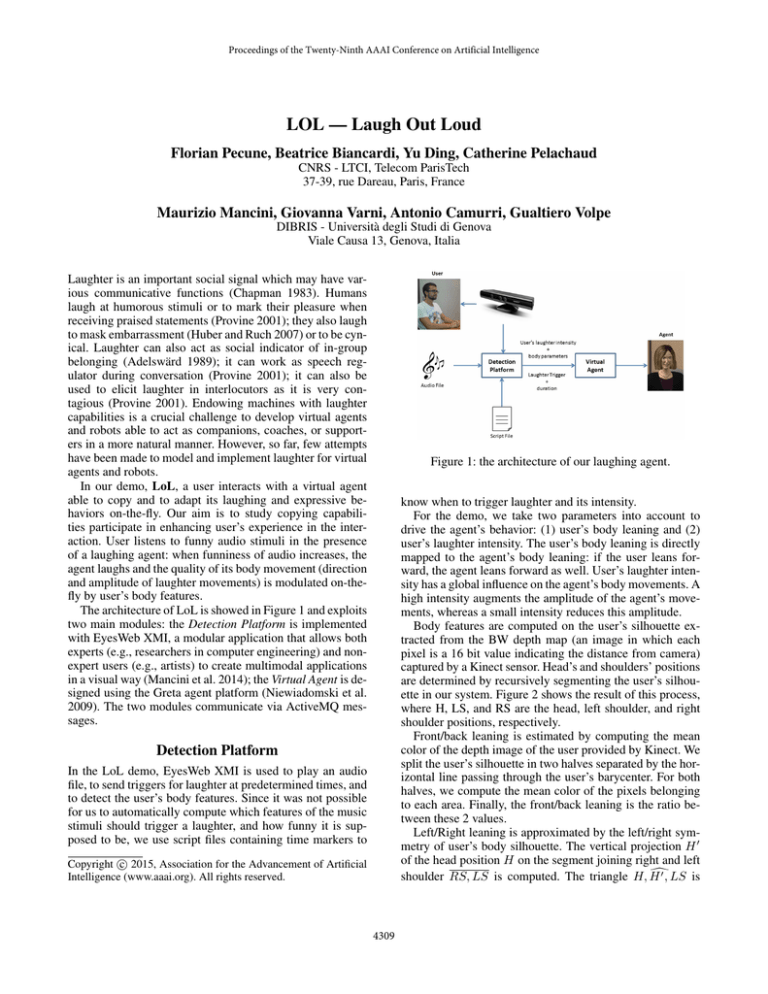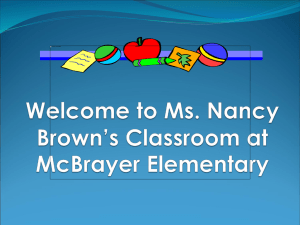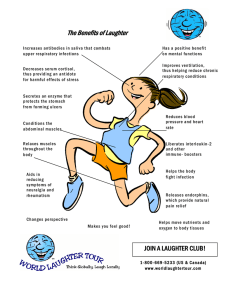
Proceedings of the Twenty-Ninth AAAI Conference on Artificial Intelligence
LOL — Laugh Out Loud
Florian Pecune, Beatrice Biancardi, Yu Ding, Catherine Pelachaud
CNRS - LTCI, Telecom ParisTech
37-39, rue Dareau, Paris, France
Maurizio Mancini, Giovanna Varni, Antonio Camurri, Gualtiero Volpe
DIBRIS - Università degli Studi di Genova
Viale Causa 13, Genova, Italia
Laughter is an important social signal which may have various communicative functions (Chapman 1983). Humans
laugh at humorous stimuli or to mark their pleasure when
receiving praised statements (Provine 2001); they also laugh
to mask embarrassment (Huber and Ruch 2007) or to be cynical. Laughter can also act as social indicator of in-group
belonging (Adelswärd 1989); it can work as speech regulator during conversation (Provine 2001); it can also be
used to elicit laughter in interlocutors as it is very contagious (Provine 2001). Endowing machines with laughter
capabilities is a crucial challenge to develop virtual agents
and robots able to act as companions, coaches, or supporters in a more natural manner. However, so far, few attempts
have been made to model and implement laughter for virtual
agents and robots.
In our demo, LoL, a user interacts with a virtual agent
able to copy and to adapt its laughing and expressive behaviors on-the-fly. Our aim is to study copying capabilities participate in enhancing user’s experience in the interaction. User listens to funny audio stimuli in the presence
of a laughing agent: when funniness of audio increases, the
agent laughs and the quality of its body movement (direction
and amplitude of laughter movements) is modulated on-thefly by user’s body features.
The architecture of LoL is showed in Figure 1 and exploits
two main modules: the Detection Platform is implemented
with EyesWeb XMI, a modular application that allows both
experts (e.g., researchers in computer engineering) and nonexpert users (e.g., artists) to create multimodal applications
in a visual way (Mancini et al. 2014); the Virtual Agent is designed using the Greta agent platform (Niewiadomski et al.
2009). The two modules communicate via ActiveMQ messages.
Figure 1: the architecture of our laughing agent.
know when to trigger laughter and its intensity.
For the demo, we take two parameters into account to
drive the agent’s behavior: (1) user’s body leaning and (2)
user’s laughter intensity. The user’s body leaning is directly
mapped to the agent’s body leaning: if the user leans forward, the agent leans forward as well. User’s laughter intensity has a global influence on the agent’s body movements. A
high intensity augments the amplitude of the agent’s movements, whereas a small intensity reduces this amplitude.
Body features are computed on the user’s silhouette extracted from the BW depth map (an image in which each
pixel is a 16 bit value indicating the distance from camera)
captured by a Kinect sensor. Head’s and shoulders’ positions
are determined by recursively segmenting the user’s silhouette in our system. Figure 2 shows the result of this process,
where H, LS, and RS are the head, left shoulder, and right
shoulder positions, respectively.
Front/back leaning is estimated by computing the mean
color of the depth image of the user provided by Kinect. We
split the user’s silhouette in two halves separated by the horizontal line passing through the user’s barycenter. For both
halves, we compute the mean color of the pixels belonging
to each area. Finally, the front/back leaning is the ratio between these 2 values.
Left/Right leaning is approximated by the left/right symmetry of user’s body silhouette. The vertical projection H 0
of the head position H on the segment joining right and left
0 , LS is
d
shoulder RS, LS is computed. The triangle H, H
Detection Platform
In the LoL demo, EyesWeb XMI is used to play an audio
file, to send triggers for laughter at predetermined times, and
to detect the user’s body features. Since it was not possible
for us to automatically compute which features of the music
stimuli should trigger a laughter, and how funny it is supposed to be, we use script files containing time markers to
c 2015, Association for the Advancement of Artificial
Copyright Intelligence (www.aaai.org). All rights reserved.
4309
Figure 2: input RGB and depth images are pre-processed to
isolate user’s body upper/lower part (red and green areas)
and head/shoulder centroids (blue dots).
Figure 3: In green, animation parameters generated from our
model. In blue, user’s parameters. In red, final animation parameters
mirrored with respect to the vertical axis and then subtracted
0 , RS. The area of the resulting shape
d
from the triangle H, H
is normalized in the range [0, 1] by dividing it by the sum of
the area of the 2 triangles.
it could decrease up to extremely low amplitude making the
agent appears to stay still.
Virtual Agent
Acknowledgement: This project has been partially financed by the European projec Ilhaire and the National
project MOCA.
During laughter the whole body moves. Our synthesized animation model computes facial expressions, head and torso
motions. It relies on our previous data-driven works (Ding
et al. 2014). Our laughter animation generator takes as input
laughter audio signals, such as its transcription into pseudophonemes (in reference to speech phoneme) including their
duration and their intensity, as well as two speech prosodic
features, namely pitch and energy. Our method allows us
to generate facial expression including lip shape of laughter as well as 3 types of motions: (1) modeling shaking-like
movement (for shoulder and torso movements); (2) emphasizing prosodic features influence on the synthesized animation; (3) taking into account the dependencies between the
movements across modalities (head and torso).
The Greta agent is able to adapt its laughter according to
the user’s behavior. While there is a direct mapping between
the user’s and the agent’s leaning, the user’s laughing intensity has an overall influence on the laughter animation. If
the user does not laugh at all and/or does not move at all, the
agent’s behavior will be inhibited, and the agent will stay
still. On the other hand, a user laughing out loud will lead
the agent to move even more.
To modify the generated animation of the agent on-the-fly,
we designed a graphical tool allowing us to manipulate different inputs and to blend them to obtain a new animation as
output (see Figure 3). Here, we blend two types of inputs: (1)
animation parameters generated by our laughter animation
model and (2) user’s parameters (body leaning and laughter intensity). These inputs are respectively represented in
Figure 3 by green circles and blue circles. The red circles
represent the final animation parameters that will be played
by the agent.
User’s laughter intensity influences not only the spine animation parameters, but also all the other body animation
parameters generated by our laughter synthesis model: if
the user laughs with large movements, the amplitude of the
agent’s movements is increased. On the other hand, if the
user does not laugh at all or perform small motions, then
the amplitude of the agent’s laugther motions is decreased;
References
Adelswärd, V. 1989. Laughter and dialogue: The social
significance of laughter in institutional discourse. Nordic
Journal of Linguistics 12(02):107–136.
Chapman, A. 1983. Humor and laughter in social interaction
and some implications for humor research. In McGhee, P.,
and Goldstein, J., eds., Handbook of humor research, Vol. 1,
135–157.
Ding, Y.; Prepin, K.; Huang, J.; Pelachaud, C.; and Artières,
T. 2014. Laughter animation synthesis. In Proceedings of
the 2014 International Conference on Autonomous Agents
and Multi-agent Systems, AAMAS ’14, 773–780.
Huber, T., and Ruch, W. 2007. Laughter as a uniform category? a historic analysis of different types of laughter. In
10th Congress of the Swiss Society of Psychology. University
of Zurich, Switzerland.
Mancini, M.; Varni, G.; Niewiadomski, R.; Volpe, G.; and
Camurri, A. 2014. How is your laugh today? In CHI’14 Extended Abstracts on Human Factors in Computing Systems,
1855–1860. ACM.
Niewiadomski, R.; Bevacqua, E.; Mancini, M.; and
Pelachaud, C. 2009. Greta: an interactive expressive eca
system. In Proceedings of The 8th International Conference on Autonomous Agents and Multiagent Systems,
volume 2, 1399–1400. International Foundation for Autonomous Agents and Multiagent Systems.
Provine, R. R. 2001. Laughter: A scientific investigation.
Penguin.
4310









